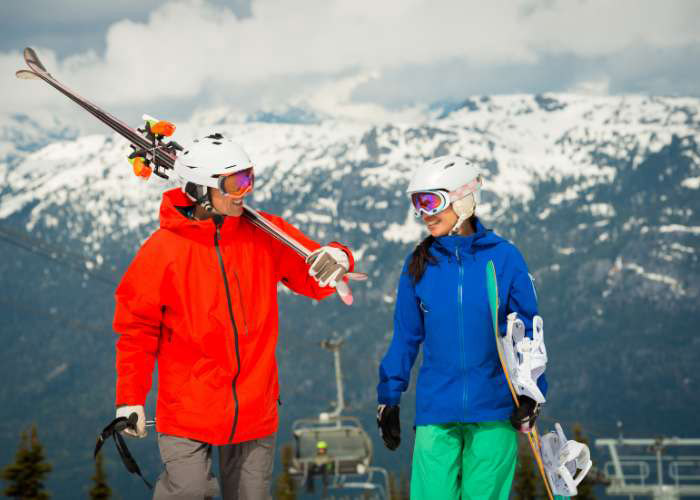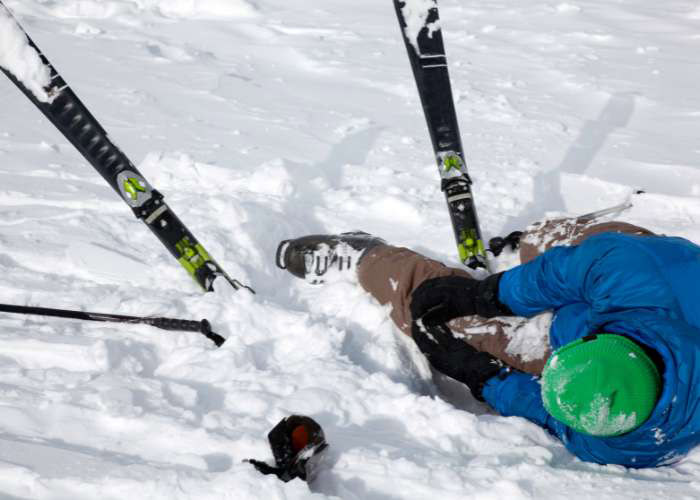It’s that time of year again! Time to hit the slopes and hear the swish of your skis through fresh powder, or to feel the slide of a perfectly groomed run as you carve your way down the mountain. Skiing is great exercise and for some can be a fun and competitive winter sport. Whether you are a beginner or a pro, skiing can be a wonderful way to spend a cold day away from work or school.
Skiing can be incredibly demanding on the body, especially the back and lower limbs which take the brunt of physical stress when you hit the slopes. It’s important to take some time and get physically ready to hit the slopes, so you have a better chance of walking away, injury free.

What are common skiing or snowboarding injuries?
Injuries to the lower extremities make up more than half of all skiing and snowboarding injuries. Common injuries for individuals and athletes in Manhattan, Brooklyn, New York City and the surrounding New York boroughs are:
Not to be outdone by hip and knee injuries, there are several upper body injuries Dr. Nwachukwu sees each ski season. The most common are:
Snowboarders are prone to concussions, as well as rotator cuff injuries and shoulder separations.

How to avoid skiing and snowboarding injuries:
It is common sense to warm up and stretch your muscles before and after any athletic activity; here are some things to do before, during and after you hit the slopes:
Prepare before you even hit the slopes:
The muscles you use in skiing and snowboarding are different than the muscles you use in any other sport or activity. Plan to work out, strengthening the muscles you need for skiing. Many places in New York offer pre-ski training classes; the ideal class will work on your legs, core, back and pelvis to increase flexibility, strength and stability.
Chose the proper gear:
New skiers should make sure their skis are the correct length and the bindings are loose, so they will pop off if you get into a risky position. Seasoned skiers can have tighter bindings. Be sure to talk to a ski equipment specialist to determine the best gear (and settings) for your level of skiing or snowboarding.
Helmets are a great idea, especially for snowboarders who tend to hit their head more often than traditional Alpine or cross-country skiers.
Don’t forget to dress appropriately too. Layering can help you maintain the best temperature so you don’t get overheated, but can keep you muscles warm.
Warm-up before attempting difficult runs:
Cold muscles are injured more easily than warm muscles so take the time to warm up. Stretching before you snap into your bindings is always a great idea. Make sure you take it slow, too – getting your muscles warmed up and ready before you take on the more difficult runs. Running in place and completing a few green runs can ready your muscles for more strenuous skiing.
Stay hydrated:
Hydration should begin before skiing or snowboarding. Drink plenty of water or drinks with electrolytes in them, to replenish the energy you’ll burn off skiing. Don’t forget to continue to hydrate after you stop for the day to help your muscles handle the added stress and lactic acid.
Don’t push it, take time to rest:
Building back up to your prior-year’s ski and snowboarding fitness level will take some time. Listen to your body and take time to recover. Overworked muscles are more prone to injury and it’s better to go slow and rest than to push yourself and sustain a season-ending injury.
What to do if you get injured or are in pain:
When starting to ski or snowboard with each new season, pain from sore muscles are normal. However, if your pain doesn’t get better, even after rest, or if skiing makes the pain worse, it’s time to see an orthopedic specialist. Some injuries won’t heal on their own and may need help from Dr. Nwachukwu. He sees many skiers and snowboarders each year and can tell you if your injury needs prompt attention with surgical treatment, or if you can be helped by a period of rest or physical therapy.
When do I need to see a doctor?
Some injuries or symptoms that skiers and snowboarder experience should be addressed right away. Here are a few reasons to see Dr. Nwachukwu:
- Any injury that causes sudden, severe pain.
- A catching sensation in your knee, hip or shoulder
- Any joint out of proper alignment
- Severe swelling of the joint or areas surrounding the joint
- Drastic decrease in range of motion
- If your knee or hip are unable to bear weight
- Any pain that doesn’t resolve within a few days
- Pain that keeps you awake at night
How frequent are ski or snowboard injuries?
The good news is skiing and snowboarding are relatively safe sports to participate in, especially if you’ve completed the steps above. Severe injuries occur more often in snowboarders than in skiers; but especially in anyone new to the sport. So take you time, listen to your body and don’t be afraid to hit the slopes!
For additional information on common skiing and snowboarding injuries, or to find out if your skiing injury needs medical intervention, please contact the office of Benedict Nwachukwu, MD, orthopedic specialist serving Manhattan, New York City and surrounding New York boroughs.





